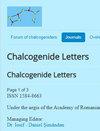SCAPS numerical design of MoSe2 solar cell for different buffer layers
IF 1.2
4区 材料科学
Q4 MATERIALS SCIENCE, MULTIDISCIPLINARY
引用次数: 0
Abstract
The solar cell capacitance simulator (SCAPS-1D) has been used to simulate, design and analyze of MoSe2, an attractive transition metal dichalcogenide (TMDC) material, based heterojunction solar cells to use it as a potential alternative to conventional absorber layers used in solar cells. The work also focuses on finding optimal absorber, buffer layer thickness and impact of operating temperature on solar cell performance with a possible replacement to toxic CdS buffer layer. It has been obtained that the optimum thickness of MoSe2 absorber layer is 1 µm and buffer layer is about 0.04 µm. The efficiency obtained with CdS based buffer layer solar cell is 20.21%. Among different buffer layers such as In2S3, ZnO, ZnOS and ZnSe, the highest efficiency obtained of MoSe2 based solar cell is 20.58% with ZnO buffer layer. ZnO buffer based solar cell shows a temperature gradient of -0.355%/K compared to -0.347%/K for CdS buffer based solar cell. The findings of this work provide important guidance to fabricate high-efficiency MoSe2 thin film solar cell with non-toxic ZnO as a potential buffer layer.不同缓冲层 MoSe2 太阳能电池的 SCAPS 数值设计
太阳能电池电容模拟器(SCAPS-1D)被用于模拟、设计和分析基于二卤化过渡金属(TMDC)材料 MoSe2 的异质结太阳能电池,将其用作太阳能电池中传统吸收层的潜在替代品。这项研究的重点还包括寻找最佳吸收层、缓冲层厚度以及工作温度对太阳能电池性能的影响,以替代有毒的 CdS 缓冲层。研究发现,MoSe2 吸收层的最佳厚度为 1 微米,缓冲层的最佳厚度约为 0.04 微米。基于 CdS 缓冲层的太阳能电池的效率为 20.21%。在 In2S3、ZnO、ZnOS 和 ZnSe 等不同缓冲层中,使用 ZnO 缓冲层的 MoSe2 太阳能电池效率最高,达到 20.58%。基于 ZnO 缓冲层的太阳能电池的温度梯度为 -0.355%/K,而基于 CdS 缓冲层的太阳能电池的温度梯度为 -0.347%/K。这项工作的发现为制造以无毒氧化锌为潜在缓冲层的高效 MoSe2 薄膜太阳能电池提供了重要指导。
本文章由计算机程序翻译,如有差异,请以英文原文为准。
求助全文
约1分钟内获得全文
求助全文
来源期刊

Chalcogenide Letters
MATERIALS SCIENCE, MULTIDISCIPLINARY-PHYSICS, APPLIED
CiteScore
1.80
自引率
20.00%
发文量
86
审稿时长
1 months
期刊介绍:
Chalcogenide Letters (CHL) has the aim to publish rapidly papers in chalcogenide field of research and
appears with twelve issues per year. The journal is open to letters, short communications and breakings news
inserted as Short Notes, in the field of chalcogenide materials either amorphous or crystalline. Short papers in
structure, properties and applications, as well as those covering special properties in nano-structured
chalcogenides are admitted.
 求助内容:
求助内容: 应助结果提醒方式:
应助结果提醒方式:


